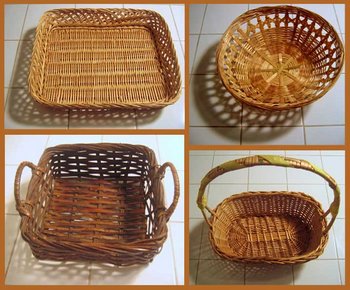Wicker
|
Wicker is any sort of hard woven plant fiber. It can be part of a plant, such as the cores of rattan stalks, or the whole thickness, as with willow switches. Wickerwork originated from stake-frame basketry. Wicker is usually used for baskets or furniture. The oldest surviving pieces of wicker furniture date from the Egyptian Empire. These pieces include chests made of reed and rush, wig boxes of reed and papyrus, and wicker hassocks and chairs. The popularity of wicker in America began around 1850 and is today beginning to find itself in a rebirth of popularity. The word wicker is believed to be of Scandinavian origin: wika which means to bend in Swedish, and vikker meaning willow. Wicker is not a material in itself, but rather an overall classification of furniture woven from any one of a variety of materials. Some of the more prominent materials being: |
 |
Rattan - presently the largest source used in the fabrication of wicker furniture. A climbing vine, native to the tropical rain forests of Southeast Asia. It commonly grows to lengths of 600 feet and diameters between 1/8 of an inch to more than 2 inches. The harvesting of rattan occurs between 7 to 15 years from the start of the new growth. Within the family of rattan, there are several hundred varieties. Rattan, unlike bamboo is a solid core vine which makes it ideal for use in making sturdy furniture.
Cane - the stem of large rattans. It has a distinct joint where the palm leaf connects to the stem, and assumes a yellow color during the drying process. Fine cane can be used to make natural wicker or for stained pieces.
Bamboo - these are large tropical grasses which commonly grow to over 100 feet. Bamboo can also grow at a tremendous rate, sometimes over 36 inches a day. Most plants grow naturally in the warm regions of temperate climates. There are approximately 500 to 1000 varieties of bamboo. It is easiest to identify due to its nodular growth and hollow stem.
Reed - this is the name given to items made by weaving swamp grasses similar to straw. Sometimes the term is also used for the core of the rattan vine. Reed is the material used on the early American wicker chairs.
Willow - this grows in the northern countries of Europe and regions of North America. It has value due to its rapid growth and for the production of light durable wood. Willow retains its natural moisture which makes it long lasting and easily woven. It can be easily identified because the diameter of each strand becomes smaller near one end.
The oldest surviving pieces of wicker furniture date from the Egyptian Empire. These pieces include chests made of reed and rush, wig boxes of reed and papyrus, and wicker hassocks and chairs. The popularity of wicker in America began around 1850 and is today beginning to find itself in a rebirth of popularity.
See also
Categories: Excellent Materials | Stylish Materials

